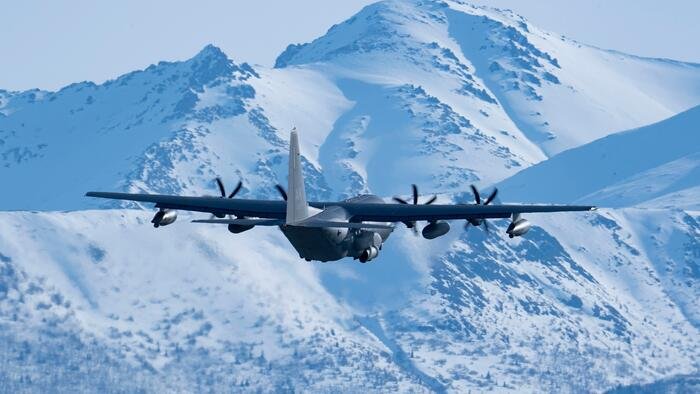Authored by Seth Cropsey via RealClearDefense,
From significant gaps in strategic transport and defense industrial base to submarine repair deficiencies, Yorktown Institute continues to emphasize shortcomings in the foundational elements crucial for maintaining U.S. military dominance globally. This article is part of that ongoing series.
The escalating tensions between China and Taiwan and Russia’s aggression in Ukraine underscore the deteriorating security landscape in Eurasia. Consequently, Congress and the military have acknowledged the gravity of the threats facing the U.S. However, budget constraints, political deadlock in Congress, and a lack of precise threat assessment have hindered America’s ability to strengthen its military capabilities and counter its adversaries effectively. It is imperative to invest in the long-term enabling capabilities that underpin U.S. strategic superiority. A comprehensive communication network extending across Alaska and connecting to its remote islands in the Bering Strait and Northern Pacific could enhance deterrence in the long term at a reasonable cost.
Despite more than two years of conflict in Ukraine, the Russian threat persists. In certain aspects, it has even intensified, particularly in the Indo-Pacific region. While the Russian Army may have suffered significant losses in Ukraine and may struggle to match NATO forces for the next few years, the Russian air force and navy possess formidable conventional and nuclear strike capabilities. Of particular significance, as recognized during the Cold War, is Russia’s nuclear submarine stronghold in the Sea of Okhotsk in the northern Pacific. Russian submarines stationed here provide Moscow with second-strike capabilities, supported by heavy bombers. Russia has also conducted multiple naval drills in the Arctic and Bering Strait, including missile tests near the U.S.-Russia maritime boundary line last autumn. With a new Cold War looming in Europe, the defense of Alaskan territory is now more crucial than it has been since the 1980s.
The growing China challenge further underscores the strategic significance of Alaska for U.S. policy. While a direct assault on Taiwan by Beijing may not be imminent due to military unpreparedness, economic ramifications, and a broader strategy of pressure against the island-nation, a confrontation between China and the U.S. in the Indo-Pacific is almost inevitable in the next decade. While China may initially prefer a non-violent absorption of Taiwan, it is willing to escalate to major conflict if necessary, given its perceived ability to prevail over the U.S. In any such conflict, crucial U.S. bases such as Okinawa, Yokosuka, Guam, and potentially Pearl Harbor would be targeted by China. By disrupting U.S. regional logistical infrastructure, China could buy time to overwhelm Taiwan and exert pressure on Japan and the Philippines.
The only viable option to sustain U.S. forces in the Indo-Pacific is through Alaskan bases and depots. These installations played a critical role during the early stages of World War II when Imperial Japan seized part of the Aleutian Islands to secure its northern flank, delay U.S. counteroffensives, and thwart an anticipated U.S.-Soviet joint attack from the Kuril Islands. Since then, the U.S. has maintained substantial military infrastructure in Alaska, including Elmendorf and Eielson Air Force Bases. Historically, the U.S. Navy operated air bases in the Aleutians, notably Dutch Harbor, for patrol and reconnaissance purposes during wartime.
U.S. policy has increasingly focused on the High North, evident in the White House’s National Arctic Strategy, the Pentagon’s Arctic Policy, and the military branches’ individual Arctic strategies. This emphasis has persisted through both the Trump and Biden administrations, reflecting a bipartisan recognition of the region’s strategic importance. Consequently, the Department of Homeland Security and multiple intelligence agencies have a vested interest in the High North. Given that Alaska is the only U.S. territory in the region, enhancing infrastructure in the state should be a top policy priority.
Efforts have been made to enhance the U.S.’ strategic position in Alaska, with all branches introducing some form of “Arctic Pay” to support equipment acquisition and boost personnel salaries due to the challenging Arctic conditions. The U.S. military has initiated plans to expand the Port of Nome, supported by a substantial budget allocated by the U.S. Army Corps of Engineers. Additionally, Congress recently approved significant funding for military installations in Alaska.
However, these initiatives do not address the critical need for improved connectivity and communication infrastructure essential for establishing situational awareness and leveraging Alaska’s strategic geography. A comprehensive communication network linking Alaska’s remote areas and coastal locations could facilitate the deployment of surveillance sites, including vital acoustic sensing capabilities for the U.S. Navy and Coast Guard, which could be expanded during wartime.
Despite the importance of such infrastructure, the Pentagon and Services have been hesitant to invest in these projects, viewing them as civilian responsibilities. Locations like St. Lawrence Island, situated less than 100 kilometers from Russia’s Chukchi Peninsula, are prime candidates for military forward positioning. However, the complexity and cost of a large-scale communication cable project, estimated at around $50 million, exceed the capabilities of state and federal agencies, necessitating coordinated development across multiple departments. Furthermore, the Pentagon has been reluctant to engage directly with medium-sized vendors capable of executing communication infrastructure projects.
The optimal solution lies in Congress mandating a major communication infrastructure project in the next National Defense Authorization Act (NDAA) with a streamlined timeline, ideally completing the project within two years and minimizing bureaucratic obstacles. By complementing this with short-term federal investments in civilian networks for deployment in strategic locations like St. Lawrence Island, the Department of Defense could leverage enhanced connectivity for Arctic surveillance and homeland defense. Establishing these enablers is imperative to ensure U.S. military superiority in the High North and maximize the strategic value of Alaska.
Seth Cropsey serves as the president of Yorktown Institute. His extensive experience as a naval officer and former Deputy Undersecretary of the Navy informs his insightful analysis. Cropsey is also the author of “Mayday” and “Seablindness“.
Loading…

